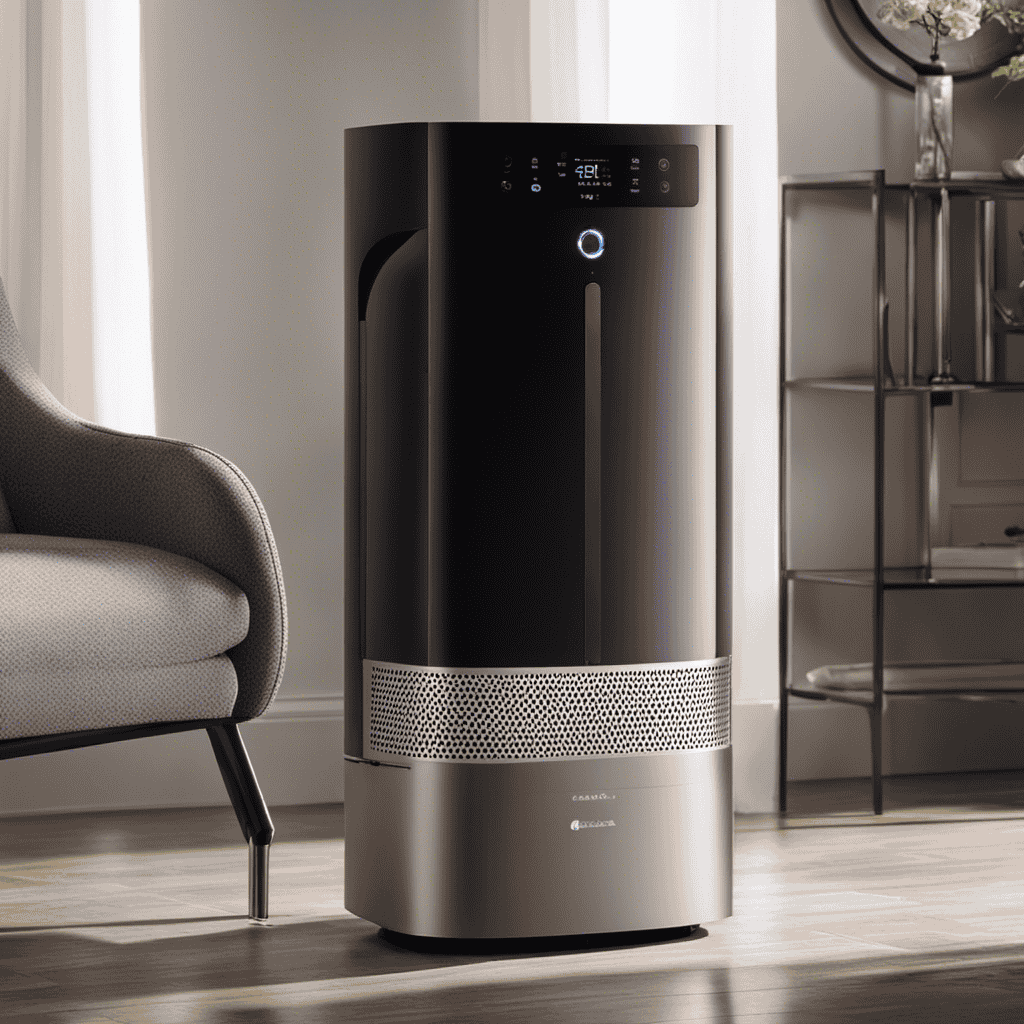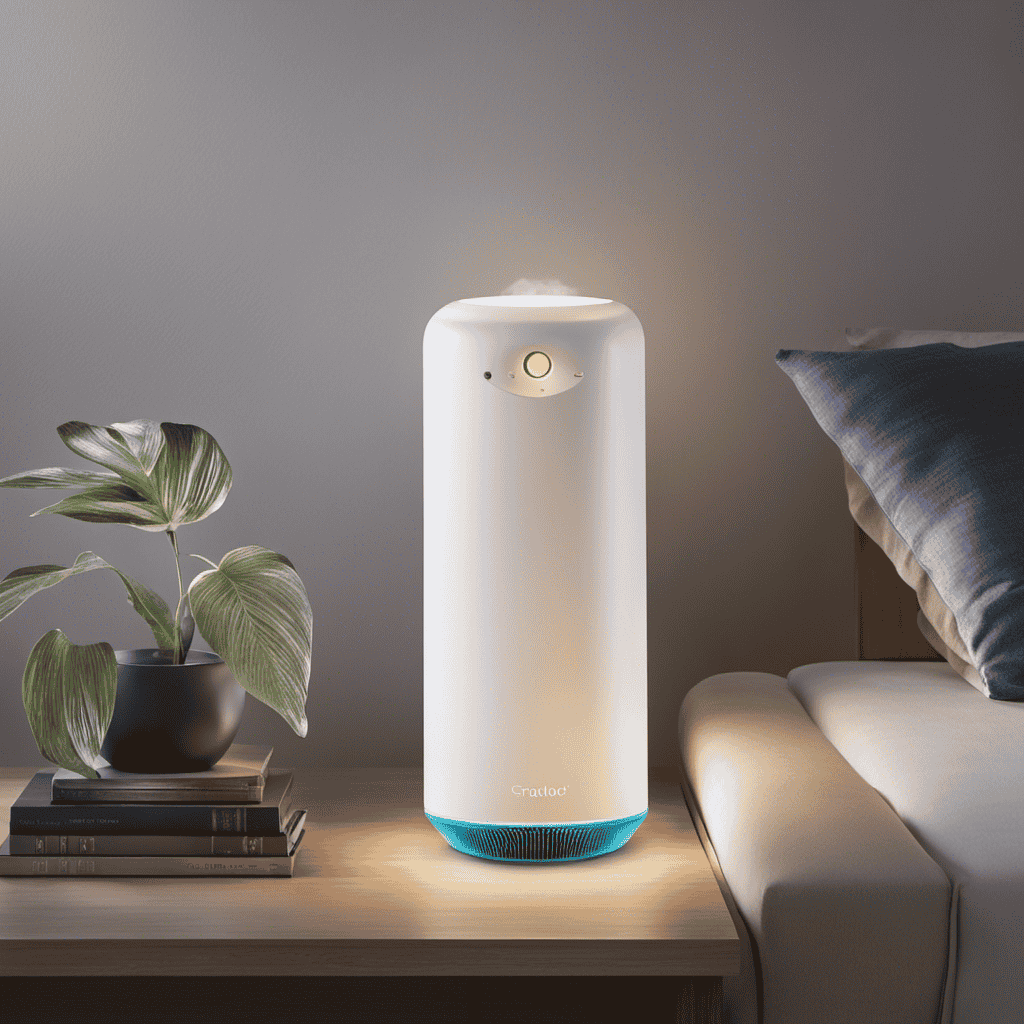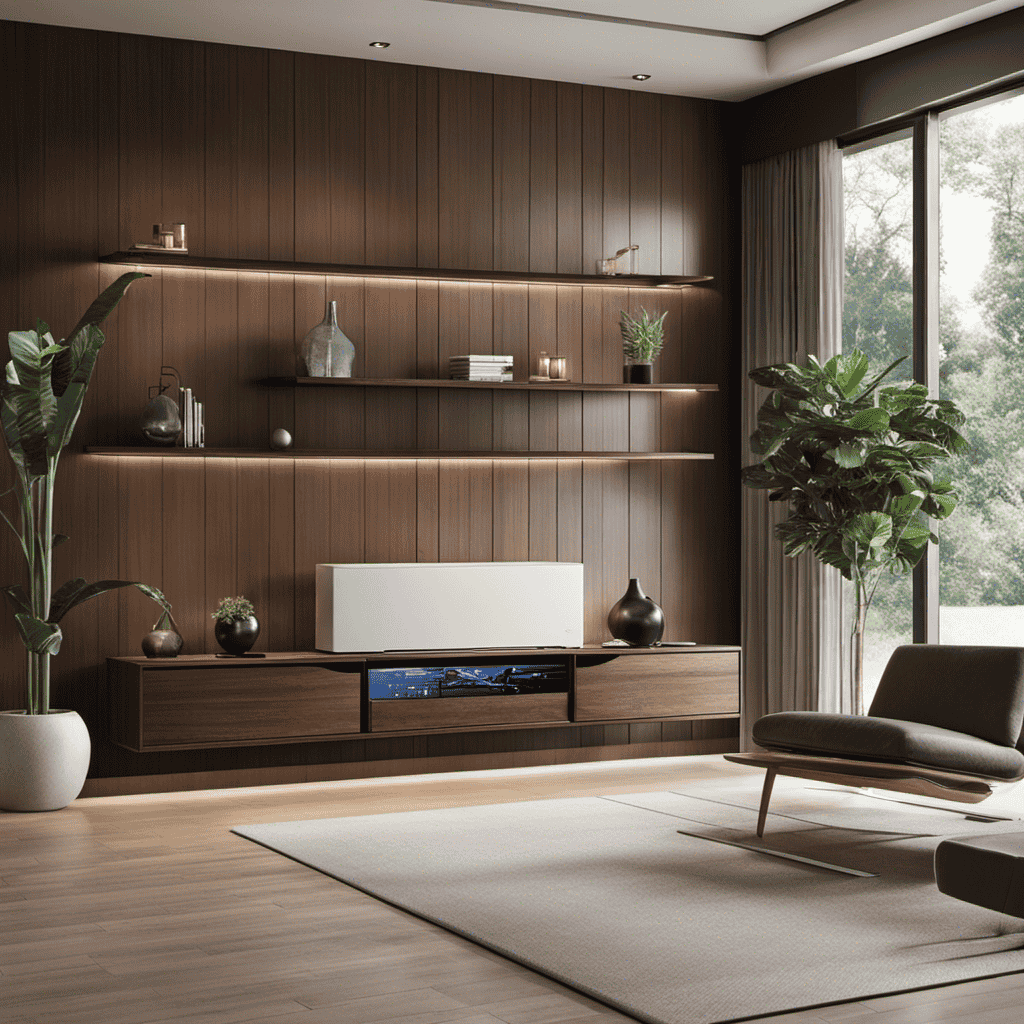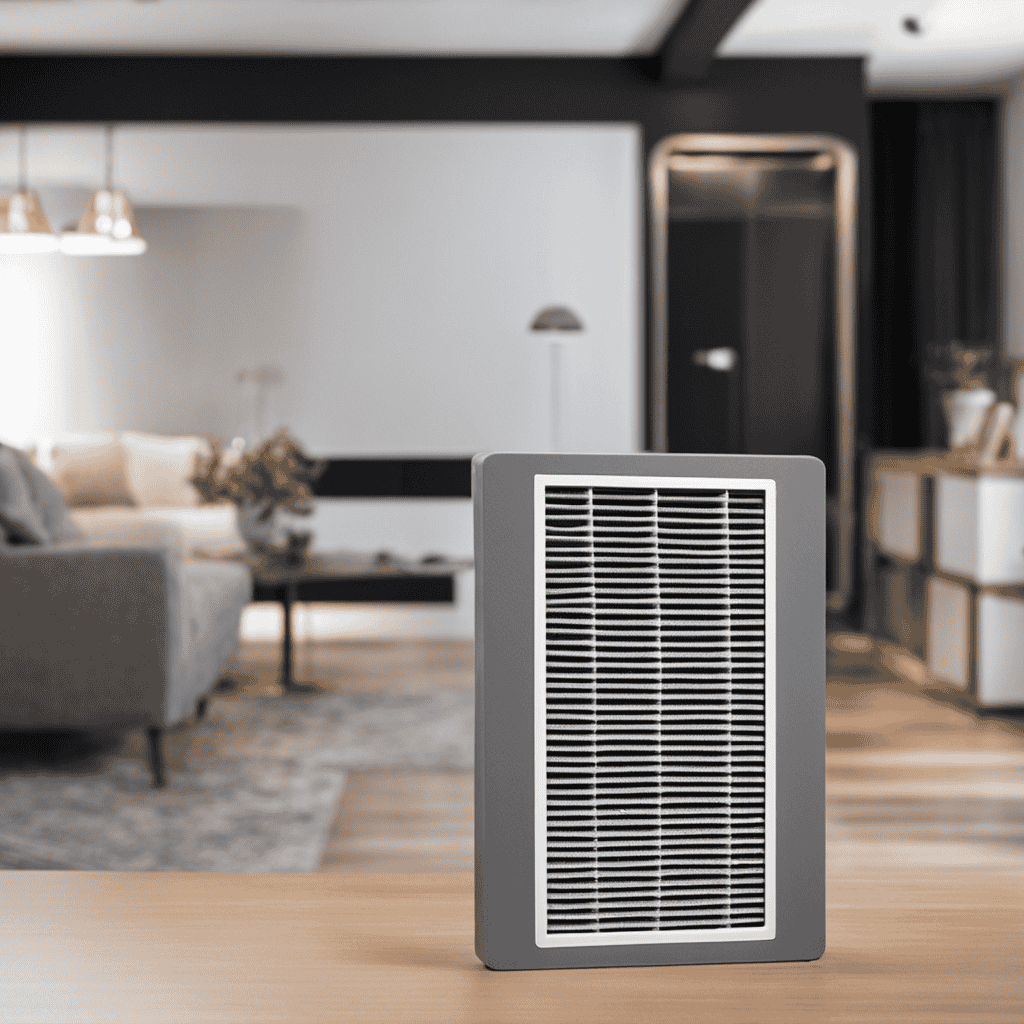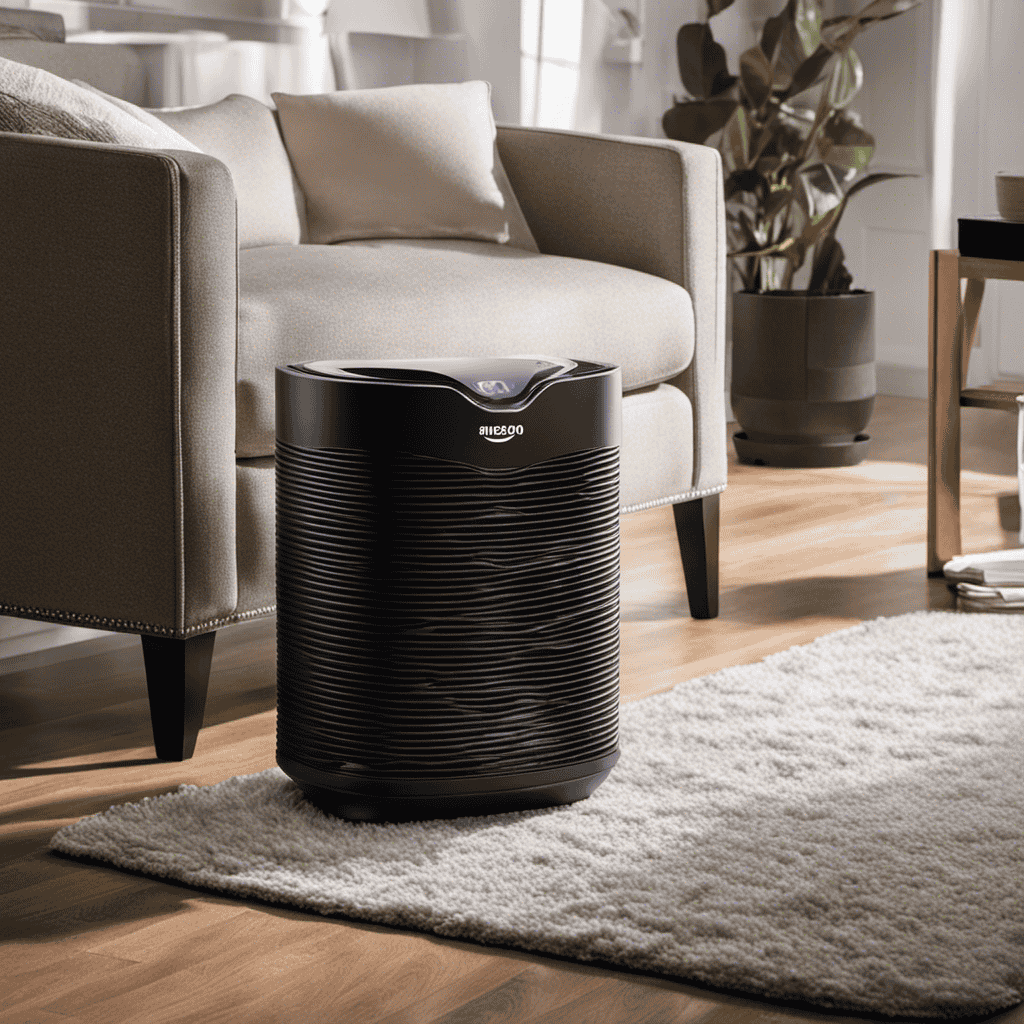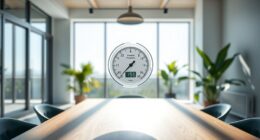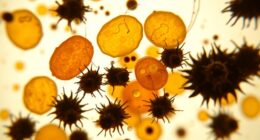As an individual who values clean air, I have always been intrigued by the function of ionizers in air purifiers.
So, what exactly is an ionizer? Well, it’s a fascinating component that actively works to improve the air quality in our homes.
In this article, we’ll explore how ionizers function, their benefits, and their potential drawbacks.
Get ready to dive into the science behind these devices and discover how they can make a difference in your indoor environment.
Key Takeaways
- Ionizers release negatively charged ions into the air, which attach to particles and make them heavier, helping to remove pollutants from the air.
- Using an ionizer in an air purifier can lead to improved air quality, better sleep quality, reduced respiratory symptoms, and enhanced overall health.
- There are two main types of ionizing technologies: negative ion generators and bipolar ionization, both of which have potential health benefits.
- Electrostatic precipitators and plasma ionizers are the two types of ionizers commonly used in air purifiers, both effectively removing particles from the air.
How Does an Ionizer Work in an Air Purifier
If you’re wondering how an ionizer works in an air purifier, it releases negatively charged ions that attach to particles in the air, causing them to become heavy and fall to the ground.
An ionizer in an air purifier can be an effective method to improve air quality by reducing airborne pollutants. It works by emitting ions, which are electrically charged particles, into the air. These ions then attach themselves to particles in the air, such as dust, pollen, or smoke.
As a result, the particles become negatively charged and heavier, causing them to be attracted to surfaces or fall to the ground. This process helps to remove these particles from the air, thus improving the overall air quality.
However, it’s important to note that the effectiveness of an ionizer can vary depending on factors such as the size of the room, the type and concentration of pollutants, and the maintenance of the air purifier. Additionally, it’s worth comparing the effectiveness of ionizers with other air purification technologies to determine the best option for your specific needs.
The Benefits of Using an Ionizer in an Air Purifier
Using an ionizer in an air purifier can have significant benefits for improving air quality and reducing allergens.
The ionizer works by releasing negatively charged ions into the air, which attach to positively charged particles like dust, pollen, and pet dander.
This process causes these particles to become heavier and fall out of the air, effectively reducing their presence in the environment and improving overall air quality.
Improved Air Quality
The ionizer in an air purifier helps to improve air quality by removing harmful particles. This can have a significant impact on our overall health and well-being. Here are three ways in which improved air quality can benefit us:
-
Improved Sleep Quality: Breathing in clean air can help promote better sleep. By removing allergens, dust, and pollutants from the air, an ionizer ensures that we are not inhaling any irritants that could disrupt our sleep patterns. This can lead to a more restful and rejuvenating sleep experience.
-
Reduced Respiratory Symptoms: Airborne particles such as pollen, pet dander, and mold spores can trigger respiratory symptoms in individuals with allergies or asthma. An ionizer can help reduce these particles, providing relief from symptoms such as coughing, wheezing, and shortness of breath.
-
Enhanced Overall Health: Breathing in clean air can have a positive impact on our overall health. By reducing exposure to pollutants, an ionizer can help prevent respiratory illnesses and improve our lung function. It can also minimize the risk of developing chronic conditions such as cardiovascular disease.
Allergen Reduction
To reduce allergens in your home, consider investing in an air purifier with an ionizer. These devices are designed to improve the air quality by removing harmful particles and allergens from the air. Allergen detection and air quality monitoring are essential features of these purifiers.
The ionizer in an air purifier works by emitting negatively charged ions into the air. These ions attach themselves to positively charged particles, such as dust, pollen, and pet dander, causing them to become heavy and fall to the ground or cling to surfaces. This helps to reduce the number of allergens floating in the air, making it safer and healthier for individuals with allergies or respiratory issues.
Understanding the role of ionizers in air purification is crucial to making an informed decision about which air purifier is best for your needs.
Understanding the Role of Ionizers in Air Purification
You might be wondering how ionizers work in air purifiers to improve air quality. Ionizers are a key component of air purifiers that help to remove pollutants and allergens from the air. Here are three important points to consider about ionizers in air purifiers:
-
Types of ionizing technologies: There are two main types of ionizing technologies used in air purifiers – negative ion generators and bipolar ionization. Negative ion generators release negatively charged ions into the air, which attach to positively charged particles like dust and pollen, causing them to fall to the ground. Bipolar ionization, on the other hand, releases both positive and negative ions that can neutralize harmful pollutants in the air.
-
Potential health benefits: Ionizers can have several potential health benefits. By removing allergens and pollutants from the air, they can help reduce allergy symptoms and improve respiratory health. Additionally, ionizers can also eliminate odors and harmful volatile organic compounds (VOCs) from the air, creating a fresher and cleaner indoor environment.
-
Improved air quality: The main purpose of ionizers in air purifiers is to improve air quality by reducing the presence of harmful particles in the air. By using ionizing technologies, air purifiers can effectively remove allergens, pollutants, and odors, resulting in cleaner and healthier indoor air.
Understanding how ionizers work in air purifiers is crucial in selecting the right air purifier for your needs. In the next section, we will explore the different types of ionizers used in air purifiers and their specific functions.
Types of Ionizers Used in Air Purifiers
If you’re curious about the types of ionizers used in air purifiers, it’s important to understand their specific functions.
Air purifier ionizers are devices that release charged particles, or ions, into the air. These ions attach to airborne particles, such as dust, pollen, and smoke, causing them to become positively or negatively charged. This process helps to remove these particles from the air, making it cleaner and healthier to breathe.
There are two main types of ionizers used in air purifiers: electrostatic precipitators and plasma ionizers. Electrostatic precipitators use an electric field to charge particles and collect them on a plate or filter. Plasma ionizers, on the other hand, use a high voltage to create ions that attach to particles and make them heavy, causing them to fall out of the air.
Both types of ionizers are effective at improving indoor air quality, but they operate in slightly different ways. Understanding the different types of ionizers used in air purifiers can help you choose the right one for your needs.
Common Misconceptions About Ionizers in Air Purifiers
One common misconception about ionizers in air purifiers is that they produce harmful ozone. However, this is not entirely true. Ionizers do produce small amounts of ozone as a byproduct of their operation, but the levels are well below the safety limits set by regulatory agencies. It’s important to understand that the ozone produced by ionizers is not harmful when present in these small quantities.
In fact, ionizers can be highly effective in improving indoor air quality.
Here are three key points to consider about the effectiveness of ionizers:
-
Ionizers work by releasing negatively charged ions into the air, which attach to airborne particles and cause them to become heavy and fall to the ground or be trapped by filters.
-
Ionizers can help remove pollutants such as dust, pollen, pet dander, and smoke particles from the air, making them particularly useful for individuals with allergies or respiratory conditions.
-
Some ionizers also have the ability to neutralize certain bacteria, viruses, and mold spores in the air, further improving indoor air quality.
Overall, while there may be misconceptions about ionizers, they can be a valuable addition to an air purifier in effectively removing airborne pollutants and improving the air we breathe.
Are Ionizers Safe to Use in Air Purifiers
When using ionizers in your air purifiers, it’s important to note that the levels of ozone produced are well below safety limits. Ionizer technology is designed to release negatively charged ions into the air, which attach to positively charged particles like dust, pollen, and smoke, causing them to become heavy and fall to the ground. This helps to remove these pollutants from the air you breathe, resulting in cleaner indoor air. However, some people may have concerns about the potential health effects of ozone produced by ionizers. It’s important to understand that ozone levels generated by ionizers are typically minimal and within safe limits. In fact, the Environmental Protection Agency (EPA) has set a safety standard for ozone levels in indoor air, ensuring that ionizers do not exceed these limits. So, you can enjoy the benefits of ionizer technology without worrying about any adverse health effects.
| Pros | Cons |
|---|---|
| Removes pollutants from the air | Minimal ozone production |
| Improves indoor air quality | Some people may be sensitive to ozone |
| Reduces allergens and irritants | Ozone levels within safe limits |
| Can be used alongside other air purification technologies |
Overall, using ionizers in air purifiers is safe and effective for improving indoor air quality. It’s important to choose a reputable air purifier brand that meets safety standards and follow the manufacturer’s instructions for proper usage. By incorporating ionizer technology into your air purifier, you can breathe easier knowing that you are taking steps to reduce pollutants and create a healthier living environment.
The Science Behind Ionization in Air Purifiers
The science behind ionization in air purifiers involves the release of negatively charged ions that attach to particles in the air, causing them to become heavy and fall to the ground, resulting in cleaner indoor air. But how does this process actually work? Here are three key points to consider:
-
Ionization: Air purifiers with ionizers use a built-in electrical charge to create negative ions. These ions are then released into the air.
-
Attraction: The negatively charged ions produced by the ionizer attach themselves to airborne particles like dust, pollen, and pet dander. This process is known as electrostatic attraction.
-
Improved air circulation: Once the particles are negatively charged, they become heavier and are no longer suspended in the air. As a result, they settle on surfaces or fall to the ground. This not only improves indoor air quality but also helps to reduce allergens and irritants.
Understanding the ionization process can help you make informed decisions when choosing an air purifier to improve air circulation and create a cleaner and healthier environment.
Comparing Ionizers to Other Air Purification Technologies
When considering air purification technologies, it’s important to compare ionizers to other options such as HEPA filters and activated carbon.
Ionizers work by releasing negatively charged ions into the air, which attach to positively charged particles and remove them from the air.
On the other hand, HEPA filters use a physical barrier to trap particles, effectively removing them from the air.
Activated carbon, on the other hand, is known for its ability to adsorb odors and chemicals, making it a popular choice for air purifiers.
Ionizers Vs. HEPA Filters
If you want cleaner air, you should consider an ionizer rather than a HEPA filter. Ionizers use a different method to purify the air, and they have their own advantages.
Here are three reasons why ionizers may be a better choice for you:
1) Ionizers vs. Ozone Generators: Unlike ozone generators, which release ozone into the air, ionizers produce negative ions that attach to airborne particles, making them heavier and causing them to fall to the ground. This process effectively removes pollutants from the air without creating harmful ozone levels.
2) Ionizers vs. Electrostatic Precipitators: While both ionizers and electrostatic precipitators use an electric charge to remove particles from the air, ionizers are generally more effective. They can remove smaller particles and have a higher efficiency rate in capturing pollutants.
3) Enhanced Air Purification: Ionizers not only remove airborne particles but also help to neutralize odors and kill bacteria and viruses. This comprehensive approach to air purification ensures a healthier and fresher environment.
Ionizers Vs. Activated Carbon
To improve the removal of odors and chemicals from your indoor space, consider using activated carbon instead of an ionizer.
Ionizers work by releasing ions into the air, which attach to particles and cause them to settle. However, ionizers have been known to produce ozone, a harmful gas that can irritate the lungs and worsen respiratory conditions.
On the other hand, activated carbon is highly effective at adsorbing odors and chemicals. It works by attracting and trapping these substances onto its surface. Activated carbon filters can be used in air purifiers to remove a wide range of pollutants, including volatile organic compounds (VOCs) and unpleasant smells.
Unlike ionizers, activated carbon filters do not produce ozone, making them a safer alternative for improving indoor air quality.
Factors to Consider When Choosing an Air Purifier With an Ionizer
One important factor in choosing an air purifier with an ionizer is the size of the room it will be used in. To help you make an informed decision, here are three factors to consider when choosing an air purifier with an ionizer:
-
Room size: It is crucial to select an air purifier with an ionizer that is suitable for the size of your room. Smaller rooms may require a smaller and more compact unit, while larger rooms may need a more powerful and high-capacity air purifier.
-
Ionizer technology: Understanding the technology behind the ionizer is essential. Ionizers work by releasing negative ions into the air, which attract and neutralize harmful particles, such as allergens, bacteria, and viruses. Look for an air purifier with an ionizer that utilizes advanced ionization technology for maximum efficiency.
-
Additional features: Consider other features offered by the air purifier, such as multiple fan speeds, air quality sensors, and filter replacement indicators. These features can enhance the overall performance and convenience of the air purifier.
How Effective Are Ionizers in Removing Airborne Pollutants
When considering the effectiveness of air purifiers, it’s important to compare the benefits and drawbacks of different technologies. For example, ionizers are known for their ability to remove certain airborne pollutants. However, they may also pose potential health risks due to the production of ozone.
Understanding these factors is crucial in making an informed decision about which type of air purifier is best suited for your needs and health concerns.
Ionizer Vs. HEPA Filter
The ionizer in an air purifier uses charged particles to remove contaminants from the air, while the HEPA filter physically traps particles for cleaner air.
When it comes to improving efficiency and considering the long-term effects, there are a few key differences between ionizers and HEPA filters that you should know:
-
Effectiveness: Ionizers are effective at removing smaller particles, such as smoke and allergens, but they may not be as effective at removing larger particles. HEPA filters, on the other hand, are highly effective at trapping particles as small as 0.3 microns.
-
Maintenance: Ionizers require regular cleaning to prevent the buildup of dirt and dust on the charged plates. HEPA filters, on the other hand, need to be replaced periodically to maintain their efficiency.
-
Ozone production: Ionizers can produce small amounts of ozone as a byproduct, which can be harmful in high concentrations. HEPA filters do not produce any ozone, making them a safer option for those concerned about air quality.
Health Risks of Ionizers?
Using an ionizer can potentially pose health risks due to the small amounts of ozone it may produce. Ozone, a molecule made up of three oxygen atoms, is a powerful oxidant that can irritate the respiratory system. When inhaled, it can cause chest pain, coughing, and shortness of breath. Prolonged exposure to ozone may also lead to lung inflammation and damage.
While ionizers can help remove particles from the air, their safety concerns cannot be ignored. It is important to note that the level of ozone generated by ionizers varies among different models. To minimize health risks, it is recommended to use ionizers in well-ventilated areas and avoid prolonged exposure.
If you have respiratory conditions or sensitivities, it is advisable to consult with a healthcare professional before using an ionizer.
Maintenance and Cleaning Tips for Air Purifiers With Ionizers
To keep your air purifier with an ionizer working effectively, don’t forget to regularly clean the filters and wipe down the exterior. Proper maintenance is essential for ensuring that your air purifier continues to provide clean and fresh air. Here are some maintenance tips and cleaning techniques to help you keep your air purifier with an ionizer in optimal condition:
-
Clean or replace the filters: The filters in your air purifier trap dust, allergens, and other particles from the air. Over time, these filters can become clogged and less effective. Regularly cleaning or replacing the filters will ensure that your air purifier can continue to effectively remove pollutants from the air.
-
Wipe down the exterior: Dust and dirt can accumulate on the exterior of your air purifier, affecting its overall performance. Wiping down the exterior with a soft cloth or using a mild cleaning solution will help keep it clean and free from debris.
-
Follow the manufacturer’s instructions: Every air purifier with an ionizer is different, so it’s important to read and follow the manufacturer’s instructions for proper maintenance and cleaning. This will ensure that you are taking the correct steps to keep your air purifier in optimal condition.
The Role of Ionizers in Eliminating Odors and VOCs
When it comes to maintaining clean and fresh indoor air, odor elimination techniques play a crucial role.
Not only can unpleasant odors affect the overall comfort of a space, but they can also indicate the presence of potentially harmful pollutants.
In this discussion, we will explore various odor elimination techniques and their impact on indoor air quality.
Odor Elimination Techniques
One popular method for reducing odors in air purifiers is with the use of an ionizer. Ionizer technology has been widely studied and proven to be effective in eliminating unpleasant smells and volatile organic compounds (VOCs) from the air.
Here are three key ways in which ionizers contribute to air purifier effectiveness:
-
Ionization: Ionizers release negatively charged ions into the air, which attach to positively charged particles like dust, pollen, and bacteria. This process causes the particles to become heavy and fall out of the air, reducing odors and improving air quality.
-
Chemical neutralization: Ionizers can also neutralize certain odorous compounds by breaking down their molecular structure. This helps eliminate smells caused by chemicals, tobacco smoke, or cooking.
-
Ozone production: Some ionizers generate small amounts of ozone, a naturally occurring gas that can help eliminate odors. However, it’s important to use ionizers with ozone production within safe limits to avoid potential health risks.
The use of ionizers in air purifiers has a significant impact on indoor air quality.
Impact on Indoor Air?
Ionizers have a significant impact on improving the quality of indoor air. They work by releasing negatively charged ions into the air, which attach to positively charged particles such as dust, pollen, and pet dander. This process, known as ionization, causes the particles to become too heavy to remain airborne and they eventually fall to the ground or get trapped on surfaces.
Indoor air pollution is a major concern as it can lead to various health effects such as allergies, asthma, and respiratory issues. By effectively removing these pollutants from the air, ionizers help to reduce the risk of these health problems.
To better understand the impact of ionizers on indoor air quality, consider the following table:
| Indoor Air Pollutant | Health Effects |
|---|---|
| Dust | Allergies, respiratory irritation, asthma exacerbation |
| Pollen | Allergic rhinitis, hay fever, asthma exacerbation |
| Pet Dander | Allergies, asthma exacerbation |
| Volatile Organic Compounds (VOCs) | Eye, nose, and throat irritation, headaches, dizziness, nausea, respiratory issues, cancer risk |
Can Ionizers Help With Allergies and Asthma
If you suffer from allergies or asthma, using an ionizer in your air purifier can potentially help alleviate symptoms. Ionizers are devices that release negatively charged ions into the air, which attach to airborne particles such as dust, pollen, and pet dander. These charged particles then become attracted to positively charged surfaces, such as walls or furniture, removing them from the air you breathe.
Here are three ways ionizers can benefit respiratory health and improve indoor air quality:
-
Reduction of allergens: Ionizers can effectively remove allergens from the air, reducing exposure and minimizing allergic reactions.
-
Neutralization of odors: Ionizers can help neutralize unpleasant odors from smoke, pets, or cooking, making the air cleaner and fresher.
-
Elimination of airborne pathogens: Ionizers can help eliminate airborne bacteria and viruses, reducing the risk of respiratory infections.
Potential Drawbacks of Using Ionizers in Air Purifiers
Using an ionizer in your air purifier may have some potential drawbacks. While ionizers can effectively remove airborne particles from your indoor environment, they also produce ozone as a byproduct. Ozone, when inhaled in high concentrations, can cause potential health effects such as respiratory irritation, coughing, and chest pain. Additionally, some studies suggest that long-term exposure to ozone may contribute to respiratory issues and worsen existing conditions like asthma.
Another concern is the environmental impact of ionizers. Ozone generated by ionizers can react with other chemicals in the air, leading to the formation of harmful pollutants like formaldehyde. It is important to consider these potential drawbacks when using an air purifier with an ionizer to ensure a safe and healthy indoor environment.
Now that we are aware of the potential drawbacks of using ionizers in air purifiers, let’s explore some tips for optimizing the performance of your air purifier with an ionizer.
Tips for Optimizing the Performance of an Air Purifier With an Ionizer
To optimize the performance of your air purifier with an ionizer, it’s essential to regularly clean or replace the filters. This will ensure that the air purifier is able to effectively remove pollutants from the air and maintain good air quality in your home.
In addition to filter maintenance, there are a few other tips you can follow to further improve the performance of your air purifier:
-
Keep the air purifier in a central location: Placing the air purifier in a central area of your home will help to improve air circulation and ensure that the purified air is evenly distributed throughout the space.
-
Use the air purifier on a regular basis: Running the air purifier consistently will help to continuously clean the air in your home and maintain good air quality. This will also help to reduce the build-up of pollutants in the air.
-
Adjust the fan speed: Most air purifiers with ionizers have adjustable fan speeds. By selecting the appropriate fan speed for your needs, you can effectively balance the air purification performance with energy consumption.
What Is the Purpose of an Ionizer in an Air Purifier?
An ionizer on air purifier works by releasing negative ions into the air, which attach to positive ions like dust and allergens, making them too heavy to remain airborne. This helps to improve air quality by removing pollutants and providing a cleaner and healthier environment for those indoors.
Frequently Asked Questions
Can Ionizers Completely Eliminate Airborne Pollutants in a Room?
Yes, ionizers can help reduce airborne pollutants in a room, but they may not completely eliminate them. It’s important to note that ionizers can produce ozone, which can have negative effects and health concerns.
Do Ionizers Produce Any Harmful Byproducts?
Ionizers in air purifiers can produce harmful byproducts, such as ozone, which can irritate the respiratory system. However, when used properly and with safety precautions, ionizers can effectively remove airborne pollutants and improve indoor air quality.
Can Ionizers Help Reduce Pet Dander and Allergens in the Air?
Ionizers can be effective in reducing pet dander and allergens in the air, making them beneficial for people with pet allergies. They can also help with asthma management by removing airborne irritants.
Are Ionizers Effective in Removing Cigarette Smoke and Odors?
Yes, ionizers can be effective in removing cigarette smoke and odors. They release negatively charged ions that attach to positively charged smoke particles, causing them to fall out of the air. This improves indoor air quality.
How Often Should the Ionizer Plates Be Cleaned or Replaced in an Air Purifier?
When it comes to the frequency of cleaning and replacement period for ionizer plates in an air purifier, it is important to follow the manufacturer’s instructions. Regular maintenance ensures optimal performance and longevity of the device.
Conclusion
In conclusion, the ionizer in an air purifier plays a crucial role in improving indoor air quality. By emitting negatively charged ions, it helps to neutralize harmful particles and pollutants in the air.
Just like a magnet attracting metal, the ionizer attracts and captures these pollutants, leaving the air cleaner and fresher.
While ionizers have their benefits, it’s important to note that they may produce ozone as a byproduct, which can be harmful in high levels. Therefore, it’s essential to choose an air purifier with a low ozone emission level for optimal air purification.
